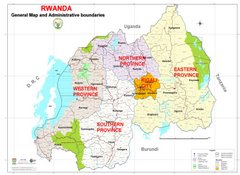
Idelphonse Nizeyimana was said to be part of the Hutu "inner circle"
Idelphonse Nizeyimana has long been one of Rwanda's most wanted men.
The former Hutu intelligence chief, reportedly arrested in the Ugandan capital, Kampala, was one of eight key suspects identified earlier this decade as central to the grisly genocide of 1994.
According to prosecutors at the UN-backed tribunal for the Rwandan genocide, which sits in Tanzania, Mr Nizeyimana gave "clear signals" to people that massacres were condoned by the Rwandan military during their early stages.
He later directly ordered killings of Tutsis and in at least one case participated in the killings himself, the indictment says.
During 100 days of bloody violence across Rwanda which began after a plane carrying the Hutu president was shot down in April, some 800,000 Tutsis and moderate Hutus were killed.
The violence was well-organised and methodically executed - bands of Hutu soldiers and local militias systematically slaughtered their Tutsi neighbours and many Hutus who refused to co-operate.
Many of them were brutally attacked with machetes before being left to die in agonising pain.
Killings and kidnappings
Idelphonse Nizeyimana was born in Gisenyi, an area of Rwanda close to Lake Kivu and the border with the Democratic Republic of Congo.
During the genocide of 1994 he held the rank of captain, serving as second-in-command and head of intelligence and military operations at Rwanda's elite military training school, the ESO.
RWANDA GENOCIDE
6 April 1994 Hutu President Juvenal Habyarimana killed when plane shot down
April - July Estimated 800,000 Tutsis and moderate Hutus killed
July Tutsi-led rebels capture capital city, Kigali
July Two million Hutus flee, sparking 15 years of unrest in the region
As a member of the same commune as Rwanda's Hutu president, he was viewed as a member of an elite "inner circle". The combination of his official rank and his privileged access gave Idelphonse Nizeyimana the power of command over officers and soldiers at the military college.
The charge sheet against Mr Nizeyimana begins with an allegation that, in the days after the shooting down of the president's plane, he took part in a swearing-in ceremony for a new regional governor in Butare that saw Rwanda's new president openly call on the people of Butare to begin massacring Tutsis.
As the killing continued and intensified, he used his authority to organise militias to carry out the massacres, setting up roadblocks which allowed killers to operate without fear of interruption, the tribunal alleges.
Capt Nizeyimana, the indictment says, "in most cases instigated, encouraged, facilitated, and or acquiesced to ... killings, kidnappings and destruction of property".
He was also complicit in a long list of raids and missions against Tutsis, including raids on a university aimed at academics, and widespread rape, sexual abuse and mutilation by soldiers under his command, it adds.
At the end of the genocide - which took place during a civil war in Rwanda that ended with Tutsi rebels taking power in Kigali - many of the perpetrators and enablers of the violence fled to neighbouring countries.
In 2002 Mr Nizeyimana was among eight fugitives named by the US as ringleaders of the genocide.
Washington offered up to $5m (£3.1m) in rewards for information leading to the capture of Augustin Bizimana, Jean-Baptiste Gatete, Augustin Bizimungu, Idelphonse Hategekimana, Augustin Ngirabatware and Callixte Nzabonimana, as well as Mr Nizeyimana.
His apparent capture in Kampala opens up the likelihood of prosecution for someone accused of being a key cog in the genocidal machine.

No comments:
Post a Comment